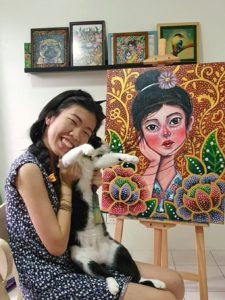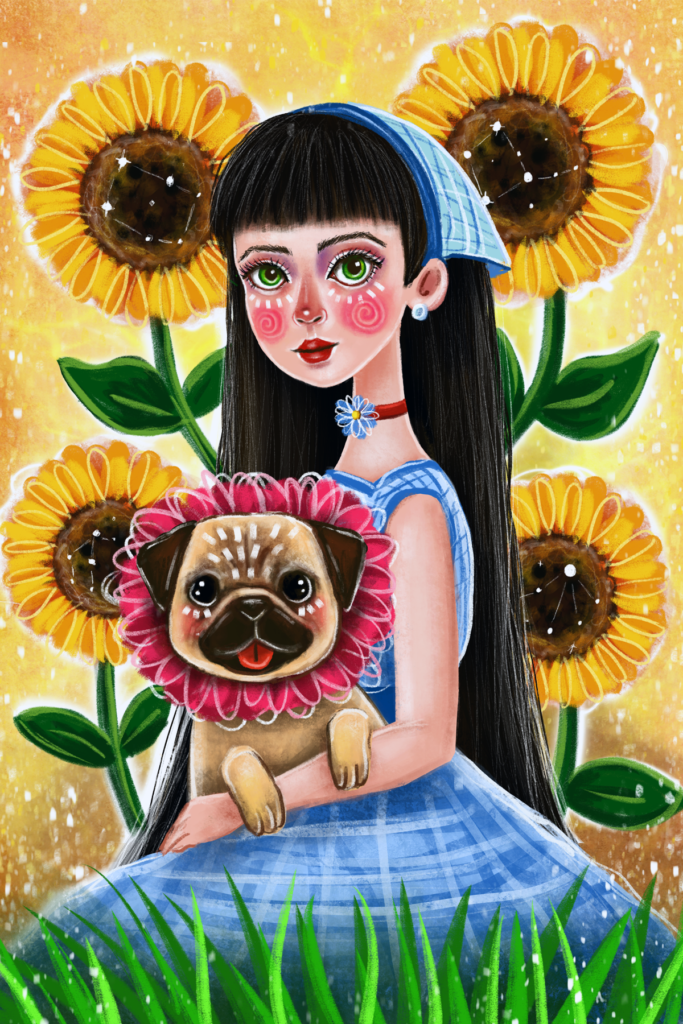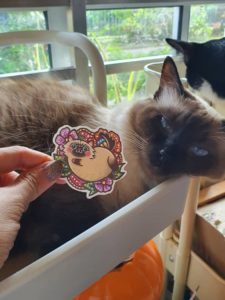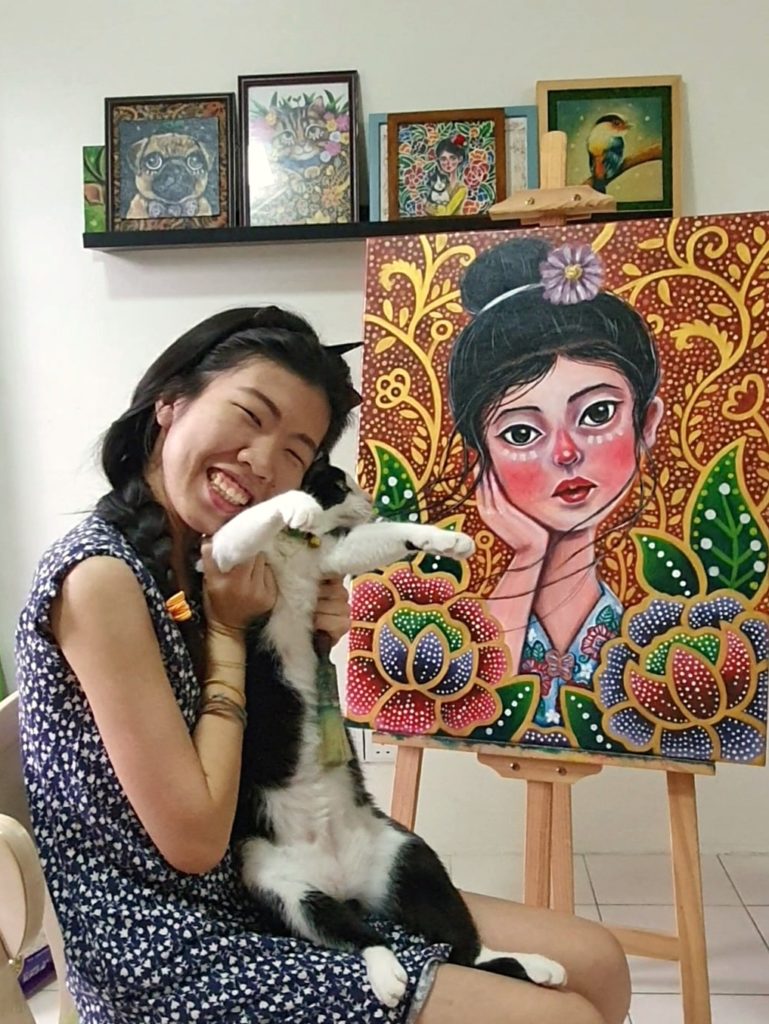I stumbled across Jean Lynn’s postcards when I went on Shopee to find some Malaysian artist postcards, the kind that I used to buy from the Art Salon, that old art gallery along Telawi 2 when that row of shops just opened. Yes, that long ago. 
I remember buying those beautiful cards with Ismail Latiff’s interpretations of fireflies on the cover, simply stunning, and sending them all over the world. And now, I was wondering if I could find something similar.
The thing is, I now have a heap of pen-pals and unlike before, where letters were the point, or rather, what was in those letters, now it’s all about bits of culture, and decorations (enter: wonderfully designed, prohibitively expensive washi tape).
So, anyway, I thought, wouldn’t it be nice to see if there were those Ismail Latiff cards around? And that’s how I came across Jean Lynn and her wonderful renditions of women of Malaysia (with cats) and various other interesting studies.
Here’s the thing: I am not a connoisseur but looking at her art always makes me happy. I ordered a whole bunch to send out to my pen-pals and other friends and everyone who received a card experienced the same frisson of joy. 
Who was this woman creating such happy, colourful, art? How much was that joy worth, especially at a time when things had become so grey and discordant?
I was determined to find out. I kept buying her postcards and finally reached out to Jean. She responded. We met at Publika and I “interviewed” her about her journey and how she came to be doing what she is doing. Then, being caught up in other projects, I neglected to write the stories that I had started accumulating for this website.
On All Saint’s Day, a day after Halloween when I had submitted the last of my projects, I decided to revive this idea. I went back to read the notes that I had faithfully transcribed from our interview, almost right off.
And so, months later, here it is:
Jean Lynn had studied animation at the Lim Kok Wing University of Creative Technology because originally, she wanted to be an animator. She loved Disney and Pixar and she could see herself doing children’s illustrations or children’s programme animation.
But things didn’t quite work out the way she had expected. “After graduation, I actually went to a few animation studios for interviews. But nobody wanted me. The nice way of putting is, they said I had my own unique style.”

Apparently, having a unique style is anathema to an animation studio. “If you work in an animation studio, you need to adapt your style to theirs. One animation needs a lot of artists, So, if your art doesn’t suit their style, mostly likely, they won’t want you. They prefer a more adaptive or general style.”
She shrugged, trying to appear nonchalant but it is obvious that this first rejection, rankled. The people who interviewed her did not only reject her for her unique style. “They said I’m too green. I was quite socially awkward at the time.”
However, not all the interviewers were mean. The last one asked Jean what it was she actually wanted to do. He told her that if she really wanted to work in a studio, she would need to learn to adapt to people’s style, work as a group, a team.
She took a moment to think about it. Did she really want to sublimate what was unique about her to create something generic and amorphous, conforming to some outside will or direction?
Turns out, she didn’t. “That’s how I made up my mind that I wanted to be an independent artist, to draw, to express what was inside me. What I got from what the last interviewer said was, I mean, how I interpreted it is, why do I need to hide myself?”
In the meantime, to pay the bills and support herself, she took a job at a café. “That was my first full-time job. It was newly opened and near my house. As I said, I was socially awkward and this job would train me to talk to people.”
She lucked out in terms of a first boss. The owner of the café told her to take her time and discover herself. She could always go out and try something and if that didn’t work out, she could come back to the café. Her job would be waiting.
“She inspired me to be independent.”
Jean started painting pictures but she didn’t quite know what to do with her art. She started making postcards with her pictures in 2017. At the time, she had discovered and was participating in the Art Market, which was one of the best ways for new artists like her to introduce their work to the public.
“My sister also told me to broaden my field. Because, you know, Malaysians don’t just buy art as art. They like keychains, art prints, postcards. And that’s why I went with postcards, because that is the easiest. And then I realised that a lot of people liked what I was doing. So, I just kept creating postcards.”
Jean used to sell her stuff at the Art Market and also, in online shops. She never considered Shopee because at the time, it had the reputation of being a place where people bought things on the cheap.

Then, the first Movement Control Order (MCO) happened and online marketplaces such as Shopee and Lazada blew up. “At first, I sold wood objects because I never really planned to sell my art stuff on Shopee. I didn’t think the crowd who shopped there was suitable; they were not an art crowd.”
Having been raised in Sabah (though she was born in Malacca) she sold coasters made of “kayu belian”. “I saw a lot of people selling wooden coasters, but these were made using a soft wood. These soft woods are easily moulded but they break apart just as easily. Kayu belian is strong wood that is both water- and fire-resistant.”
There was a market there and she wasn’t really tied to those products. She hadn’t created them. They did not have her lifeblood running through their veins. But slowly, she started putting up her art. “Since I already had a shop, I thought, why not? Just put everything there.”
It was then that she realised there was a market for her “art” stuff on Shopee; what she calls, “the journaling crowd”.
“These are people who buy a lot of postcards to send to their friends. They also like to buy things like washi tape, stickers, pens for their journaling. Some of them buy postcards just to stick in their journals,” she says.
A lot of Jean’s friends design washi tape and have it printed in China but she hasn’t gotten into that yet. “You need a minimum order quantity and I don’t want to deal with that.”
The journaling crowd tends to be close-knit and when one member does something, others will soon follow. “That is why, when one of the girls bought my stuff, her friends slowly started buying from me as well; postcards, stickers…I do cat and dog stickers too.”
Jean puts her work on Instagram and Facebook. “I draw what I love and I put it online. Artists have to put their work online. It is one of the ways to get exposure; it’s like a portfolio. Then people see what you can do, they learn what your style is, and whether it is suitable for their commissions.”
She also does murals. Her first was in the café she worked at. “They wanted to put up pictures of their food on the wall to grab attention and I said, why not let me paint it, let me try…if you don’t like it, you can just paint it over.”
She didn’t get paid for the mural but it became part of her portfolio. “It’s not advisable to give free art but that was my first mural and I knew them, so I said, nemmindloh,” she laughs.

Jean dabbled in everything – for her, it was not the medium, but the art itself that mattered. She was developing her style. She soon realised that she loved drawing anything linked to Malaysia. “When I tried to draw non-Malaysian attire, I found, I couldn’t and I became demotivated about continuing.”
Then she started drawing a girl in nyonya attire and her interest was rekindled. “It inspired me to go on. I draw what I love.”
She can tell what she was feeling when she looks back at her art of the time.
“It’s like a lens in front of your eyes, like you’re wearing spectacles with different-coloured glasses. So, when I am happy, whatever I draw is brighter. If I’m sad or down, whatever I draw is really bloody or darker, greyish, muted. It’s like a diary. When I look back and something I’ve created, I can say, oh, I know what I was feeling at that time.”

Her emotions affect her art. And so does her appetite. She cannot paint hungry. “Because if I’m hungry, the colours I see are very confusing, I can’t focus on anything. I could when I was younger but now, I get stuck and nothing seems right anymore.”
Cats started making an appearance in her work because of a personal rescue story. A neighbour’s cat got pregnant and left her kittens in front of Jean and her sister’s front door and ran away.
“We would babysit the kittens and she would only come back once a day to feed them. So, we usually needed to bottle feed them as well. Sometimes, I would walk around the neighbourhood to find the mother cat and bring her back to feed her babies. Now, I don’t see her anymore. I don’t where she is.”
There were three kittens. When they were first left on her doorstep, they had just opened their eyes. Although she and her sister were happy to help out (seeing as they didn’t have a choice), they were not attached to the kittens, to begin with. Then, as they grew, they became frisky and unmanageable. One day, one kitten climbed up a car tyre, another fell into the large drain (Jean needed to get a ladder in to rescue him) while the third was with the mother.
It was raining at the time and the one that had run up the tyre to hide was covered in black oil. Luckily the car hadn’t moved since morning or it would have been crushed. “I was so grateful (that nothing had happened to him) I wanted to cry. So, I said, OK, I jaga (look after) you.
“Actually, we planned to adopt one, but it didn’t make sense because we didn’t know which to choose. There was one that looked Siamese, and the other two were tuxedos. We chose the pretty one but we liked one of the tuxedos as well. So, why not choose two?
“But how to choose two and leave out the third one? So that’s how we ended up adopting all three. Because there are three of us – me, my sister and my brother-in-law. By the end of the year, my sister and her husband will move out. But the cats will remain in our house,” she says.

Jean’s sister acts as her business manager: “She is more logical because I don’t like to price my work. Like if people ask me how much I charge to draw something, I find it very draining. I’m constantly worrying if it is too expensive for them, or too cheap and therefore, not worth my time doing it. So, I ask my sister, is this price OK? And she’ll tell me if it is. Then I just proceed. If they don’t want, it’s OK too. But that’s the price.”
To begin with, her parents were not thrilled by her choice of career. They did not say so directly, but kept trying to push her to try her out her prospects in Singapore. “That’s when I realised that my dad was a bit anxious too. My mother was quite upfront about it but my dad, was like, why not you try this or that?”
But they came to accept her rather peripatetic existence without a fixed paycheck when their friends started taking notice of her work and praising it. Also, they soon realised that times had changed and many of their friends’ children were freelancing.
“My uncle and auntie told my parents, ‘aiya, children nowadays, let them do whatever they want. If they can earn a living, let them be.’ That was when my dad started to change and become supportive.”
Jean has received inquiries from overseas from people who want to buy her postcards but she says the Shopee system may not be ideal. “If you want to sell outside Malaysia, you need to hit a certain quota for your one month of sales. But Shopee sets the price, not you. For instance, I sell my postcards at RM5 in Malaysia and I could sell it at S$5 per card in Singapore but they don’t allow me to. It has to be RM5 converted into Singapore dollars so there’s not much of an incentive to go overseas. Also, postage charges are now very high.”
Ever since the pandemic, postage has gone up by more than 100%. “Some people see my work on Insta and they PM (personal message) me. If they really want it, they send me a screenshot and I will sell to them separately. I give them the Malaysian price, so some of them are willing to pay the postage fee.”
Once, some customers from Brunei wanted to buy postcards and keychains, which would have made two small packets. “Last time, the postage would have been only RM20. The flexi packet is a fixed price but you need to pay for the tracking number. But tracking is now RM12, RM13. However, I need the tracking, in case it gets lost, I know where the package is stuck. So, when you total everything up it was RM40.”
But for Bruneians however, when you convert the currency, it is one third that number for them. If Shopee’s rules on pricing remain as restrictive, she points out, she has no motivation to sell to the rest of Southeast Asia, although, clearly there is a market for her products there.

She also does commissions. A lot of people love her girls and cats series and want to be painted with their cats.
Jean is now 32. What are her dreams and aspirations?
“My immediate goal is to get to a point where I am able to sustain myself and get a more stable income. But my main goal is to continue creating.
“I can do that anywhere, anytime. I paint on both canvas and computers. My art cards are drawn on the computer but I also create canvas paintings. Not too big though, because my room right now is rather small, so I am a bit malas (lazy) to create big ones, because if I create, I won’t know where to put them.”
She sells her canvas paintings at a much higher price. “They are limited. I have this series, the batik girls, and so far, I have only sold one, the Kadazan girl. I have priced these paintings at RM5,000. It may be expensive and I can compromise on everything else not but not my canvases. This is the price I set.”

Love this piece… and this artist’s work! Keep the stories comin’, Jen! ❤
An enjoyable and uplifting piece, Jen. Keep on writing.
And all the best to Jean with her artwork. Lovely!
“Frisson of joy” is exactly how it feels to get one of those beautiful postcards. It was wonderful and inspiring to read about the artist. Thanks to you both for sharing her story.
How wonderfully encapsulated by you (Jean’s journey and her art). Keep ‘em flowing, Jens!!